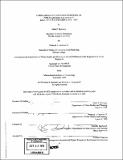A risk-adjusted performance history of public and private market real estate investment, 1978-1997
Author(s)
Moriarty, Mark P. (Mark Paul), 1964-; Yeatman, Pennock J. 1970-
DownloadFull printable version (6.173Mb)
Other Contributors
Massachusetts Institute of Technology. Dept. of Urban Studies and Planning.
Advisor
Timothy Riddiough.
Terms of use
Metadata
Show full item recordAbstract
Since the inception of the Real Estate Investment Trust ("REIT"), the relative efficiency of the public and private real estate markets has been the subject of debate. Consequently, a determination of the more efficient real estate investment vehicle will probably have a significant effect on the future flow of capital into all real estate assets. This thesis proposes to identify which real estate investment medium, public or private, has provided greater efficiency to its investors as measured by risk adjusted total return over the 20 year period from 1978-1997. The initial objective of this thesis was to create a publicly traded real estate equity index(the "Thesis index") for comparison to the existing National Association of Real Estate Investment Trusts ("NAREIT") equity index in an effort to replicate the returns of the latter. This equity Thesis index is an annual weighted compilation of the total returns of each existing equity REIT, as identified by a query of the Compustat database, for each given year from 1978 through 1997. Returns were calculated as of the calendar year end commencing in 1978 and continuing through calendar year end 1997. The core objective of this thesis was to ultimately compare the de-levered Thesis index to the existing National Council of Real Estate Investment Fiduciaries ("NCREIF") index in order to determine which index has provided a greater risk adjusted return over the time series in question. Given the disparities in the risk profiles of the underlying indices and the need to ensure a homogeneous comparison, adjustments to the Thesis index have been made in order to compensate for leverage in the REIT capital structure, for the presence of development risk in the current REIT asset base, and for the respective weight of each real estate asset class within the NCREIF index.
Description
Thesis (S.M.)--Massachusetts Institute of Technology, Dept. of Urban Studies and Planning, 1999. Includes bibliographical references (leaves 51-54).
Date issued
1999Department
Massachusetts Institute of Technology. Department of Urban Studies and PlanningPublisher
Massachusetts Institute of Technology
Keywords
Urban Studies and Planning.